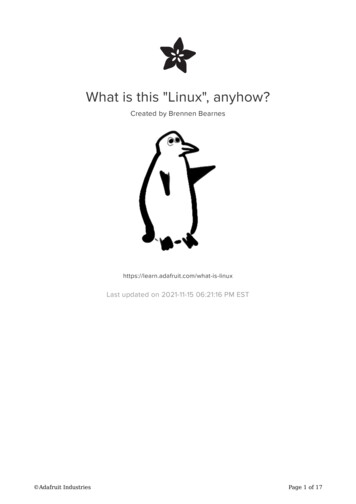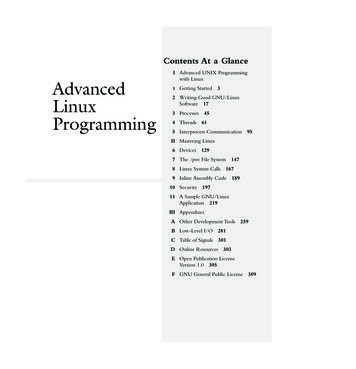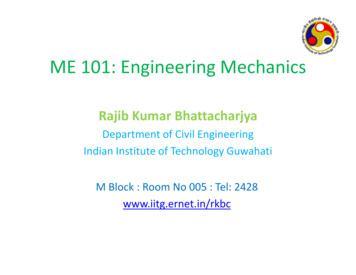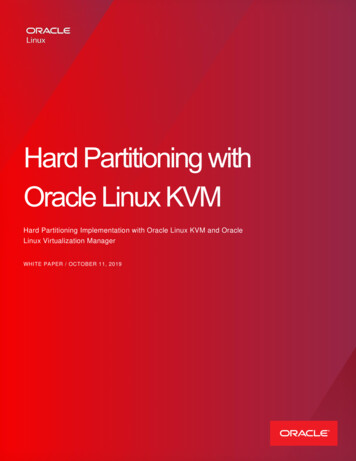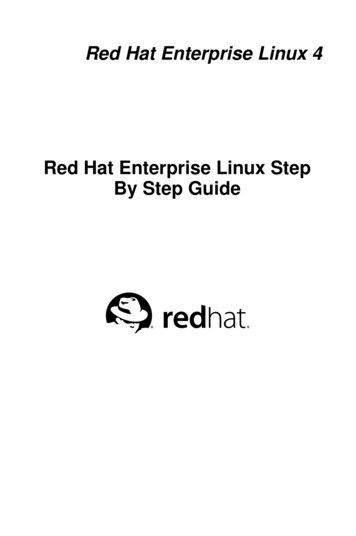
Transcription
,TITLE.9502 Page i Thursday, January 27, 2005 12:06 PMLINUXDEVICEDRIVERS
,TITLE.9502 Page ii Thursday, January 27, 2005 12:06 PMOther Linux resources from O’ReillyRelated titlesLinux BooksResource CenterUnderstanding the LinuxKernelLinux in a NutshellRunning LinuxLinux NetworkAdministrator’s GuideLinux Pocket GuideBuilding Embedded LinuxSystemsDesigning EmbeddedHardwarelinux.oreilly.com is a complete catalog of O’Reilly’s books onLinux and Unix and related technologies, including samplechapters and code examples.ONLamp.com is the premier site for the open source web platform: Linux, Apache, MySQL, and either Perl, Python, or PHP.ConferencesO’Reilly brings diverse innovators together to nurture the ideasthat spark revolutionary industries. We specialize in documenting the latest tools and systems, translating the innovator’sknowledge into useful skills for those in the trenches. Visit conferences.oreilly.com for our upcoming events.Safari Bookshelf (safari.oreilly.com) is the premier online reference library for programmers and IT professionals. Conductsearches across more than 1,000 books. Subscribers can zero inon answers to time-critical questions in a matter of seconds.Read the books on your Bookshelf from cover to cover or simply flip to the page you need. Try it today with a free trial.
,TITLE.9502 Page iii Thursday, January 27, 2005 12:06 PMLINUXDEVICEDRIVERSTHIRD EDITIONMaster Q03/18/2005Jonathan Corbet, AlessandroRubini, and Greg Kroah-HartmanBeijing Cambridge Farnham Köln Paris Sebastopol Taipei Tokyo
,COPYRIGHT.10321 Page iv Thursday, January 27, 2005 12:09 PMLinux Device Drivers, Third Editionby Jonathan Corbet, Alessandro Rubini, and Greg Kroah-HartmanCopyright 2005, 2001, 1998 O’Reilly Media, Inc. All rights reserved.Printed in the United States of America.Published by O’Reilly Media, Inc., 1005 Gravenstein Highway North, Sebastopol, CA 95472.O’Reilly books may be purchased for educational, business, or sales promotional use. Online editionsare also available for most titles (safari.oreilly.com). For more information, contact our corporate/institutional sales department: (800) 998-9938 or corporate@oreilly.com.Editor:Andy OramProduction Editor:Matt HutchinsonProduction Services:Octal Publishing, Inc.Cover Designer:Edie FreedmanInterior Designer:Melanie WangPrinting History:February 1998:First Edition.June 2001:Second Edition.February 2005:Third Edition.Nutshell Handbook, the Nutshell Handbook logo, and the O’Reilly logo are registered trademarks ofO’Reilly Media, Inc. The Linux series designations, Linux Device Drivers, images of the American West,and related trade dress are trademarks of O’Reilly Media, Inc.Many of the designations used by manufacturers and sellers to distinguish their products are claimed astrademarks. Where those designations appear in this book, and O’Reilly Media, Inc. was aware of atrademark claim, the designations have been printed in caps or initial caps.While every precaution has been taken in the preparation of this book, the publisher and authorsassume no responsibility for errors or omissions, or for damages resulting from the use of theinformation contained herein.This work is licensed under the Creative Commons Attribution-NonCommercial-ShareAlike 2.0License. To view a copy of this license, visit http://creativecommons.org/licenses/by-sa/2.0/ or send aletter to Creative Commons, 559 Nathan Abbott Way, Stanford, California 94305, USA.This book uses RepKover , a durable and flexible lay-flat binding.ISBN: 0-596-00590-3[M]
,ldr3TOC.fm.4587 Page v Thursday, January 20, 2005 9:30 AMTable of ContentsPreface . . . . . . . . . . . . . . . . . . . . . . . . . . . . . . . . . . . . . . . . . . . . . . . . . . . . . . . . . . . . . . . . . xi1. An Introduction to Device Drivers . . . . . . . . . . . . . . . . . . . . . . . . . . . . . . . . . . . . . 1The Role of the Device DriverSplitting the KernelClasses of Devices and ModulesSecurity IssuesVersion NumberingLicense TermsJoining the Kernel Development CommunityOverview of the Book2458101112122. Building and Running Modules . . . . . . . . . . . . . . . . . . . . . . . . . . . . . . . . . . . . . . 15Setting Up Your Test SystemThe Hello World ModuleKernel Modules Versus ApplicationsCompiling and LoadingThe Kernel Symbol TablePreliminariesInitialization and ShutdownModule ParametersDoing It in User SpaceQuick Reference151618222830313537393. Char Drivers . . . . . . . . . . . . . . . . . . . . . . . . . . . . . . . . . . . . . . . . . . . . . . . . . . . . . . . 42The Design of scullMajor and Minor NumbersSome Important Data Structures424349v
,ldr3TOC.fm.4587 Page vi Thursday, January 20, 2005 9:30 AMChar Device Registrationopen and releasescull’s Memory Usageread and writePlaying with the New DevicesQuick Reference5558606370704. Debugging Techniques . . . . . . . . . . . . . . . . . . . . . . . . . . . . . . . . . . . . . . . . . . . . . 73Debugging Support in the KernelDebugging by PrintingDebugging by QueryingDebugging by WatchingDebugging System FaultsDebuggers and Related Tools7375829193995. Concurrency and Race Conditions . . . . . . . . . . . . . . . . . . . . . . . . . . . . . . . . . . . 106Pitfalls in scullConcurrency and Its ManagementSemaphores and MutexesCompletionsSpinlocksLocking TrapsAlternatives to LockingQuick Reference1071071091141161211231306. Advanced Char Driver Operations . . . . . . . . . . . . . . . . . . . . . . . . . . . . . . . . . . . 135ioctlBlocking I/Opoll and selectAsynchronous NotificationSeeking a DeviceAccess Control on a Device FileQuick Reference1351471631691711731797. Time, Delays, and Deferred Work . . . . . . . . . . . . . . . . . . . . . . . . . . . . . . . . . . . 183Measuring Time LapsesKnowing the Current TimeDelaying ExecutionKernel TimersTaskletsvi Table of Contents183188190196202
,ldr3TOC.fm.4587 Page vii Thursday, January 20, 2005 9:30 AMWorkqueuesQuick Reference2052088. Allocating Memory . . . . . . . . . . . . . . . . . . . . . . . . . . . . . . . . . . . . . . . . . . . . . . . 213The Real Story of kmallocLookaside Cachesget free page and Friendsvmalloc and FriendsPer-CPU VariablesObtaining Large BuffersQuick Reference2132172212242282302319. Communicating with Hardware . . . . . . . . . . . . . . . . . . . . . . . . . . . . . . . . . . . . 235I/O Ports and I/O MemoryUsing I/O PortsAn I/O Port ExampleUsing I/O MemoryQuick Reference23523924524825510. Interrupt Handling . . . . . . . . . . . . . . . . . . . . . . . . . . . . . . . . . . . . . . . . . . . . . . . 258Preparing the Parallel PortInstalling an Interrupt HandlerImplementing a HandlerTop and Bottom HalvesInterrupt SharingInterrupt-Driven I/OQuick Reference25925926927527828128611. Data Types in the Kernel . . . . . . . . . . . . . . . . . . . . . . . . . . . . . . . . . . . . . . . . . . . 288Use of Standard C TypesAssigning an Explicit Size to Data ItemsInterface-Specific TypesOther Portability IssuesLinked ListsQuick Reference28829029129229529912. PCI Drivers . . . . . . . . . . . . . . . . . . . . . . . . . . . . . . . . . . . . . . . . . . . . . . . . . . . . . . . 302The PCI InterfaceA Look Back: ISAPC/104 and PC/104 302319322Table of Contents vii
,ldr3TOC.fm.4587 Page viii Thursday, January 20, 2005 9:30 AMOther PC BusesSBusNuBusExternal BusesQuick Reference32232332432532513. USB Drivers . . . . . . . . . . . . . . . . . . . . . . . . . . . . . . . . . . . . . . . . . . . . . . . . . . . . . . 327USB Device BasicsUSB and SysfsUSB UrbsWriting a USB DriverUSB Transfers Without UrbsQuick Reference32833333534635636014. The Linux Device Model . . . . . . . . . . . . . . . . . . . . . . . . . . . . . . . . . . . . . . . . . . . 362Kobjects, Ksets, and SubsystemsLow-Level Sysfs OperationsHotplug Event GenerationBuses, Devices, and DriversClassesPutting It All TogetherHotplugDealing with FirmwareQuick Reference36437137537738739139740540715. Memory Mapping and DMA . . . . . . . . . . . . . . . . . . . . . . . . . . . . . . . . . . . . . . . . 412Memory Management in LinuxThe mmap Device OperationPerforming Direct I/ODirect Memory AccessQuick Reference41242243544045916. Block Drivers . . . . . . . . . . . . . . . . . . . . . . . . . . . . . . . . . . . . . . . . . . . . . . . . . . . . . 464RegistrationThe Block Device OperationsRequest ProcessingSome Other DetailsQuick Referenceviii Table of Contents465471474491494
,ldr3TOC.fm.4587 Page ix Thursday, January 20, 2005 9:30 AM17. Network Drivers . . . . . . . . . . . . . . . . . . . . . . . . . . . . . . . . . . . . . . . . . . . . . . . . . . 497How snull Is DesignedConnecting to the KernelThe net device Structure in DetailOpening and ClosingPacket TransmissionPacket ReceptionThe Interrupt HandlerReceive Interrupt MitigationChanges in Link StateThe Socket BuffersMAC Address ResolutionCustom ioctl CommandsStatistical InformationMulticastA Few Other DetailsQuick 754054218. TTY Drivers . . . . . . . . . . . . . . . . . . . . . . . . . . . . . . . . . . . . . . . . . . . . . . . . . . . . . . . 546A Small TTY Drivertty driver Function PointersTTY Line Settingsioctlsproc and sysfs Handling of TTY DevicesThe tty driver Structure in DetailThe tty operations Structure in DetailThe tty struct Structure in DetailQuick Reference548553560564566567569571573Bibliography . . . . . . . . . . . . . . . . . . . . . . . . . . . . . . . . . . . . . . . . . . . . . . . . . . . . . . . . . . . 575Index . . . . . . . . . . . . . . . . . . . . . . . . . . . . . . . . . . . . . . . . . . . . . . . . . . . . . . . . . . . . . . . . . 579Table of Contents ix
,ldr3TOC.fm.4587 Page x Thursday, January 20, 2005 9:30 AM
,ch00.11770 Page xi Thursday, January 27, 2005 12:11 PMPrefaceThis is, on the surface, a book about writing device drivers for the Linux system.That is a worthy goal, of course; the flow of new hardware products is not likely toslow down anytime soon, and somebody is going to have to make all those new gadgets work with Linux. But this book is also about how the Linux kernel works andhow to adapt its workings to your needs or interests. Linux is an open system; withthis book, we hope, it is more open and accessible to a larger community of developers.This is the third edition of Linux Device Drivers. The kernel has changed greatlysince this book was first published, and we have tried to evolve the text to match.This edition covers the 2.6.10 kernel as completely as we are able. We have, this timearound, elected to omit the discussion of backward compatibility with previous kernel versions. The changes from 2.4 are simply too large, and the 2.4 interfaceremains well documented in the (freely available) second edition.This edition contains quite a bit of new material relevant to the 2.6 kernel. The discussion of locking and concurrency has been expanded and moved into its ownchapter. The Linux device model, which is new in 2.6, is covered in detail. There arenew chapters on the USB bus and the serial driver subsystem; the chapter on PCI hasalso been enhanced. While the organization of the rest of the book resembles that ofthe earlier editions, every chapter has been thoroughly updated.We hope you enjoy reading this book as much as we have enjoyed writing it.Jon’s IntroductionThe publication of this edition coincides with my twelth year of working with Linuxand, shockingly, my twenty-fifth year in the computing field. Computing seemed likea fast-moving field back in 1980, but things have sped up a lot since then. KeepingLinux Device Drivers up to date is increasingly a challenge; the Linux kernel hackerscontinue to improve their code, and they have little patience for documentation thatfails to keep up.xiThis is the Title of the Book, eMatter EditionCopyright 2005 O’Reilly & Associates, Inc. All rights reserved.
,ch00.11770 Page xii Thursday, January 27, 2005 12:11 PMLinux continues to succeed in the market and, more importantly, in the hearts andminds of developers worldwide. The success of Linux is clearly a testament to itstechnical quality and to the numerous benefits of free software in general. But thetrue key to its success, in my opinion, lies in the fact that it has brought the fun backto computing. With Linux, anybody can get their hands into the system and play in asandbox where contributions from any direction are welcome, but where technicalexcellence is valued above all else. Linux not only provides us with a top-qualityoperating system; it gives us the opportunity to be part of its future development andto have fun while we’re at it.In my 25 years in the field, I have had many interesting opportunities, from programming the first Cray computers (in Fortran, on punch cards) to seeing the minicomputer and Unix workstation waves, through to the current, microprocessordominated era. Never, though, have I seen the field more full of life, opportunity,and fun. Never have we had such control over our own tools and their evolution.Linux, and free software in general, is clearly the driving force behind those changes.My hope is that this edition helps to bring that fun and opportunity to a new set ofLinux developers. Whether your interests are in the kernel or in user space, I hopeyou find this book to be a useful and interesting guide to just how the kernel workswith the hardware. I hope it helps and inspires you to fire up your editor and tomake our shared, free operating system even better. Linux has come a long way, butit is also just beginning; it will be more than interesting to watch—and participatein—what happens from here.Alessandro’s IntroductionI’ve always enjoyed computers because they can talk to external hardware. So, aftersoldering my devices for the Apple II and the ZX Spectrum, backed with the Unixand free software expertise the university gave me, I could escape the DOS trap byinstalling GNU/Linux on a fresh new 386 and by turning on the soldering iron onceagain.Back then, the community was a small one, and there wasn’t much documentationabout writing drivers around, so I started writing for Linux Journal. That’s howthings started: when I later discovered I didn’t like writing papers, I left the univeristy and found myself with an O’Reilly contract in my hands.That was in 1996. Ages ago.The computing world is different now: free software looks like a viable solution,both technically and politically, but there’s a lot of work to do in both realms. I hopethis book furthers two aims: spreading technical knowledge and raising awarenessabout the need to spread knowledge. That’s why, after the first edition proved interesting to the public, the two authors of the second edition switched to a free license,xii PrefaceThis is the Title of the Book, eMatter EditionCopyright 2005 O’Reilly & Associates, Inc. All rights reserved.
,ch00.11770 Page xiii Thursday, January 27, 2005 12:11 PMsupported by our editor and our publisher. I’m betting this is the right approach toinformation, and it’s great to team up with other people sharing this vision.I’m excited by what I witness in the embedded arena, and I hope this text helps bydoing more; but ideas are moving fast these days, and it’s already time to plan for thefourth edition, and look for a fourth author to help.Greg’s IntroductionIt seems like a long time ago that I picked up the first edition of this Linux DeviceDrivers book in order to figure out how to write a real Linux driver. That first edition was a great guide to helping me understand the internals of this operating system that I had already been using for a number of years but whose kernel had nevertaken the time to look into. With the knowledge gained from that book, and by reading other programmers’ code already present in the kernel, my first horribly buggy,broken, and very SMP-unsafe driver was accepted by the kernel community into themain kernel tree. Despite receiving my first bug report five minutes later, I washooked on wanting to do as much as I could to make this operating system the bestit could possibly be.I am honored that I’ve had the ability to contribute to this book. I hope that itenables others to learn the details about the kernel, discover that driver developmentis not a scary or forbidding place, and possibly encourage others to join in and helpin the collective effort of making this operating system work on every computingplatform with every type of device available. The development procedure is fun, thecommunity is rewarding, and everyone benefits from the effort involved.Now it’s back to making this edition obsolete by fixing current bugs, changing APIsto work better and be simpler to understand for everyone, and adding new features.Come along; we can always use the help.Audience for This BookThis book should be an interesting source of information both for people who wantto experiment with their computer and for technical programmers who face the needto deal with the inner levels of a Linux box. Note that “a Linux box” is a wider concept than “a PC running Linux,” as many platforms are supported by our operatingsystem, and kernel programming is by no means bound to a specific platform. Wehope this book is useful as a starting point for people who want to become kernelhackers but don’t know where to start.On the technical side, this text should offer a hands-on approach to understandingthe kernel internals and some of the design choices made by the Linux developers.Although the main, official target of the book is teaching how to write device drivers,the material should give an interesting overview of the kernel implementation as well.Preface This is the Title of the Book, eMatter EditionCopyright 2005 O’Reilly & Associates, Inc. All rights reserved.xiii
,ch00.11770 Page xiv Thursday, January 27, 2005 12:11 PMAlthough real hackers can find all the necessary information in the official kernelsources, usually a written text can be helpful in developing programming skills. Thetext you are approaching is the result of hours of patient grepping through the kernel sources, and we hope the final result is worth the effort it took.The Linux enthusiast should find in this book enough food for her mind to startplaying with the code base and should be able to join the group of developers that iscontinuously working on new capabilities and performance enhancements. Thisbook does not cover the Linux kernel in its entirety, of course, but Linux devicedriver authors need to know how to work with many of the kernel’s subsystems.Therefore, it makes a good introduction to kernel programming in general. Linux isstill a work in progress, and there’s always a place for new programmers to jump intothe game.If, on the other hand, you are just trying to write a device driver for your own device,and you don’t want to muck with the kernel internals, the text should be modularized enough to fit your needs as well. If you don’t want to go deep into the details,you can just skip the most technical sections, and stick to the standard API used bydevice drivers to seamlessly integrate with the rest of the kernel.Organization of the MaterialThe book introduces its topics in ascending order of complexity and is divided intotwo parts. The first part (Chapters 1–11) begins with the proper setup of kernel modules and goes on to describe the various aspects of programming that you’ll need inorder to write a full-featured driver for a char-oriented device. Every chapter covers adistinct problem and includes a quick summary at the end, which can be used as areference during actual development.Throughout the first part of the book, the organization of the material moves roughlyfrom the software-oriented concepts to the hardware-related ones. This organizationis meant to allow you to test the software on your own computer as far as possiblewithout the need to plug external hardware into the machine. Every chapter includessource code and points to sample drivers that you can run on any Linux computer.In Chapters 1 and 1, however, we ask you to connect an inch of wire to the parallelport in order to test out hardware handling, but this requirement should be manageable by everyone.The second half of the book (Chapters 12–18) describes block drivers and networkinterfaces and goes deeper into more advanced topics, such as working with the virtual memory subsystem and with the PCI and USB buses. Many driver authors donot need all of this material, but we encourage you to go on reading anyway. Muchof the material found there is interesting as a view into how the Linux kernel works,even if you do not need it for a specific project.xiv PrefaceThis is the Title of the Book, eMatter EditionCopyright 2005 O’Reilly & Associates, Inc. All rights reserved.
,ch00.11770 Page xv Thursday, January 27, 2005 12:11 PMBackground InformationIn order to be able to use this book, you need to be confident with C programming.Some Unix expertise is needed as well, as we often refer to Unix semantics about system calls, commands, and pipelines.At the hardware level, no previous expertise is required to understand the material inthis book, as long as the general concepts are clear in advance. The text isn’t basedon specific PC hardware, and we provide all the needed information when we dorefer to specific hardware.Several free software tools are needed to build the kernel, and you often need specific versions of these tools. Those that are too old can lack needed features, whilethose that are too new can occasionally generate broken kernels. Usually, the toolsprovided with any current distribution work just fine. Tool version requirementsvary from one kernel to the next; consult Documentation/Changes in the source treeof the kernel you are using for exact requirements.Online Version and LicenseThe authors have chosen to make this book freely available under the Creative Commons “Attribution-ShareAlike” license, Version entions Used in This BookThe following is a list of the typographical conventions used in this book:ItalicUsed for file and directory names, program and command names, command-lineoptions, URLs, and new termsConstant WidthUsed in examples to show the contents of files or the output from commands,and in the text to indicate words that appear in C code or other literal stringsConstant Width ItalicUsed to indicate text within commands that the user replaces with an actualvalueConstant Width BoldUsed in examples to show commands or other text that should be typed literallyby the userPreface This is the Title of the Book, eMatter EditionCopyright 2005 O’Reilly & Associates, Inc. All rights reserved.xv
,ch00.11770 Page xvi Thursday, January 27, 2005 12:11 PMPay special attention to notes set apart from the text with the following icons:This is a tip. It contains useful supplementary information about thetopic at hand.This is a warning. It helps you solve and avoid annoying problems.Using Code ExamplesThis book is here to help you get your job done. In general, you may use the code inthis book in your programs and documentation. The code samples are covered by adual BSD/GPL license.We appreciate, but do not require, attribution. An attribution usually includes thetitle, author, publisher, and ISBN. For example: “Linux Device Drivers, Third Edition, by Jonathan Corbet, Alessandro Rubini, and Greg Kroah-Hartman. Copyright2005 O’Reilly Media, Inc., 0-596-00590-3.”We’d Like to Hear from YouPlease address comments and questions concerning this book to the publisher:O’Reilly Media, Inc.1005 Gravenstein Highway NorthSebastopol, CA 95472(800) 998-9938 (in the United States or Canada)(707) 829-0515 (international or local)(707) 829-0104 (fax)We have a web page for this book, where we list errata, examples, and any additional information. You can access this page at:http://www.oreilly.com/catalog/linuxdrive3To comment or ask technical questions about this book, send email to:bookquestions@oreilly.comFor more information about our books, conferences, Resource Centers, and theO’Reilly Network, see our web site at:http://www.oreilly.comxvi PrefaceThis is the Title of the Book, eMatter EditionCopyright 2005 O’Reilly & Associates, Inc. All rights reserved.
,ch00.11770 Page xvii Thursday, January 27, 2005 12:11 PMSafari EnabledWhen you see a Safari Enabled icon on the cover of your favorite technology book, that means the book is available online through theO’Reilly Network Safari Bookshelf.Safari offers a solution that’s better than e-books. It’s a virtual library that lets youeasily search thousands of top tech books, cut and paste code samples, downloadchapters, and find quick answers when you need the most accurate, current information. Try it for free at http://safari.oreilly.com.AcknowledgmentsThis book, of course, was not written in a vacuum; we would like to thank the manypeople who have helped to make it possible.Thanks to our editor, Andy Oram; this book is a vastly better product as a result ofhis efforts. And obviously we owe a lot to the smart people who have laid the philosophical and practical foundations of the current free software renaissance.The first edition was technically reviewed by Alan Cox, Greg Hankins, Hans Lermen, Heiko Eissfeldt, and Miguel de Icaza (in alphabetic order by first name). Thetechnical reviewers for the second edition were Allan B. Cruse, Christian Morgner,Jake Edge, Jeff Garzik, Jens Axboe, Jerry Cooperstein, Jerome Peter Lynch, MichaelKerrisk, Paul Kinzelman, and Raph Levien. Reviewers for the third edition wereAllan B. Cruse, Christian Morgner, James Bottomley, Jerry Cooperstein, PatrickMochel, Paul Kinzelman, and Robert Love. Together, these people have put a vastamount of effort into finding problems and pointing out possible improvements toour writing.Last but certainly not least, we thank the Linux developers for their relentless work.This includes both the kernel programmers and the user-space people, who often getforgotten. In this book, we chose never to call them by name in order to avoid beingunfair to someone we might forget. We sometimes made an exception to this ruleand called Linus by name; we hope he doesn’t mind.JonI must begin by thanking my wife Laura and my children Michele and Giulia for filling my life with joy and patiently putting up with my distraction while working onthis edition. The subscribers of LWN.net have, through their generosity, enabledmuch of this work to happen. The Linux kernel developers have done me a great service by letting me be a part of their community, answering my questions, and settingme straight when I got confused. Thanks are due to readers of the second edition ofthis book whose comments, offered at Linux gatherings over much of the world,Preface This is the Title of the Book, eMatter EditionCopyright 2005 O’Reilly & Associates, Inc. All rights reserved.xvii
,ch00.11770 Page xviii Thursday, January 27, 2005 12:11 PMhave been gratifying and inspiring. And I would especially like to thank AlessandroRubini for starting this whole exercise with the first edition (and staying with itthrough the current edition); and Greg Kroah-Hartman, who has brought his considerable skills to bear on several chapters, with great results.AlessandroI would like to thank the people that made this work possible. First of all, the incredible patience of Federica, who went as far as letting me review the first edition during our honeymoon, with a laptop in the tent. I want to thank Giorgio and Giulia,who have been involved in later editions of the book and happily accepted to be sonsof “a gnu” who often works late in the night. I owe a lot to all the free-softwareauthors who actually taught me how to program by making their work available foranyone to study. But for this edition, I’m mostly grateful to Jon and Greg, who havebeen great mates in this work; it couldn’t have existed without each and both ofthem, as the code base is bigger and tougher, while my time is a scarcer resource,always contended for by clients, free software issues, and expired deadlines. Jon hasbeen a great leader for this edition; both have been very productive and technicallyinvaluable in supplementing my small-scale and embedded view toward programming with their expertise about SMP and number crunchers.GregI would like to thank my wife Shannon and my children Madeline and Griffin fortheir understanding and patience while I took the time to work on this book. If itwere not for their support of my original Linux development efforts, I would not beable to do this book at all. Thanks also to Alessandro and Jon for offering to let mework on this book; I am honored that they let me participate in it. Much gratitude isgiven to all of the Linux kernel programmers, who were unselfish enough to writecode in the public view, so that I and others could learn so much from just reading it.Also, for everyone who has ever sent me bug reports, critiqued my code, and flamedme for doing stupid things, you have all taught me so much about how to be a betterprogrammer and, throughout it all, made me feel very welcome to be part of thiscommunity. Thank you.xviii PrefaceThis is the Title of the Book, eMatter EditionCopyright 2005 O’Reilly & Associates, Inc. All rights reserved.
,ch01.2168 Page 1 Thursday, January 20, 2005 9:21 AMChapter 1CHAPTER 1An Introduction toDevice DriversOne of the many advantages of free operating systems, as typified by Linux, is thattheir internals are open for all to view. The operating system, once a dark and mysterious area whose code was restricted to a small number of programmers, can now bereadily examined, understood, and modified by anybody with the requisite skills.Linux has helped to democratize operating systems. The Linux kernel remains alarge and complex body of code, however, and would-be kernel hackers need anentry point where they can approach the code wit
Related titles Understanding the Linux Kernel Linux in a Nutshell Running Linux Linux Network Administrator’s Guide Linux Pocket Guide Building Embedded Linux Systems Designing Embedded Hardware Linux Books Resource Center linux.oreilly.com is a complete catalog of O’Reilly’s books on Linux




